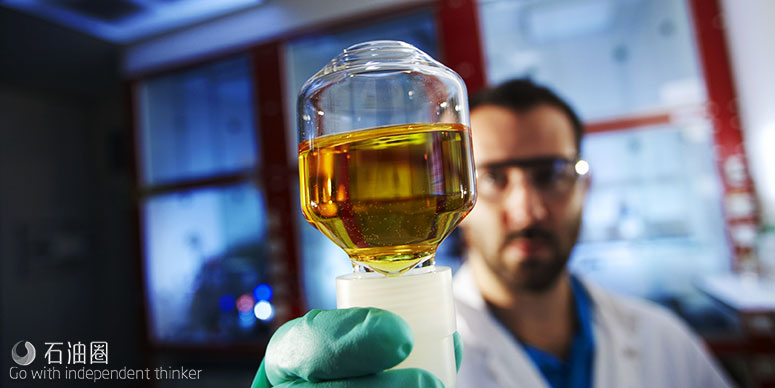Without the visual impact of a drilling rig structure and related equipment, mud pits seem to be a more benign aspect of “making hole.” Yet, with the cost of drilling mud as high as 10 percent of total drilling expense, the fluid had better do its job well. Ensuring optimal performance has even prompted operators to assign separate day and night mud engineers.
Since mud is that important, what about additives? Drill fluid additives play a unique role, from helping overcome multiple drilling challenges to ideally maximize downhole drilling efficiency and saving operators time and money. In this environment, one company introduced an additive to help deal with laterals, verticals and curves.
R&D Innovation
Despite mud’s ordinary appearance, its job is quite challenging. It has to remove cuttings, minimize corrosion, lubricate and support both the drilling assembly and the bit, and control formation pressures. Additives are just as integral as the mud itself. They can reduce fluid loss, provide surfactants, and weight compounds and dispersants, to name a few. Yet what makes the critical difference between additives is exceptional high pressure lubricity which provides an array of advantages.
Several years ago it became clear that drill fluid additive capabilities had not been pushed high enough. Working with a general concept about re-inventing additives, one company developed an extreme pressure (EP) drill fluid conditioner that technologically connects the advanced lubrication of another additive with a powder having asphalt benefits.
The company wanted to combine a mud conditioner that stabilizes shale formations with a powerful friction-reducing element, packaged as powder for easy dispersal in either water-based or oil-based mud. Once developed, the company saw that this combination provided the best of both worlds in not only lubricity but also related advantages that make drilling better, more efficient and more cost-effective.
Drill site advantages include: exceptional high temperature fluid loss control; greatly reduced torque and drag, along with reducing bit balling/wear and differential sticking; much improved shale inhibition and stabilization; drill string corrosion considerably reduced; increased seepage and lost circulation material (LCM) control; and a thin, tough and slick drill cake.
In the Field
Typically, when R&D moves out of the lab into production and distribution, drilling engineers may not readily accept a new mud additive and want test results substantiating product statements. Two types of testing have delivered some eye-opening numbers for this new additive. When a group of major oil companies expressed an interest in the additive but wanted more than sales literature, competitive lubricants went head-to-head and the new conditioner not only outperformed all the competitors but at a 1.5 percent concentration against their 7.5 percent. Validation was also requested about coefficient of friction reduction. The new conditioner produced results that were three times lower, again at a lower concentration. In other words, operators get more power while spending less on the product.
In the field, mud engineers continue saying that this additive “has turned ordinary muds into super muds.” On a representative well in Texas, the additive benefits resulted in a net savings of more than $20,000. According to the operator, this additive accomplished everything from a performance perspective that typically required a sulfonated asphalt and it reduced torque in doing so. Taking that “replacement” factor further, being multi-purpose allows operators to either reduce or eliminate not only sulfonated asphalt but also wall cake enhancers, wetting agents, other high-pressure/high-temperature (HPHT) fluid loss control additives, as well as gilsonite and lubricants by employing this conditioner for downhole drilling.
Additionally, the additive is eco-friendly and in offshore usage is completely non-toxic to marine life, as determined by very strict international testing and standards. Above all, however, is the field-proven ability to dramatically improve the efficiency of drilling fluid systems. In the oil industry’s technological evolution, this is why more and more operators are revising their thinking from “A mud is a mud” and specifying this next-gen 2-in-1 drill fluid conditioner.
DIAMOND DUST
Drill Fluid Conditioner
2-In-1 Wellbore Stabilizer & Lubricant
ProOne DIAMOND DUST combines and extreme pressure (EP) drill fluid with the benefits of an asphalt powder. DIAMOND DUST is a mud conditioner that stabilizes shale formations with a thin, tough and slick filter cake and helps wells get to TD faster with ProOne’s friction reducing XPL+ Technology.
This combination provides the best of both worlds making drilling more efficient and more cost-effective. DIAMOND DUST essentially replaces or reduces the need for high-pressure lubricants, shale Inhibitors, shale stabilizers, wallcake enhancers, HPHT fluid loss control additives, and sulfonated asphalts.
Description
1.Dark Brown to Black Powder.
2.Highly dispersable in either water based muds, oil based muds, and brine.
Mixing Requirements:
1.Use conventional mud hopper system
2.Add 1 sack per 8 barrels of drilling fluid over 4-5 circulations for initial “mud-up”
Advantages
1.Exceptional HP lubricity for reduction of torque, drag, differential sticking, bit balling & bit wear
2.Enables a thin, tough and slick filter cake
3.Enhances shale inhibition and stabilization
4.Superior high temperature fluid loss control
5.Improves cleaning of drill cuttings
6.Reduces corrosion on drill strings
7.Ideal for seepage and LCM control
8.Totally environmentally friendly.
Maintenance Requirements:
1.Daily additions of 1 sack per 8 barrels of drilling fluid suggested
BIO-STABLE Drilling Fluid Conditioner
EPA Approved For Offshore Use Biodegradable Drilling Fluid
ProOne’s BIO-STABLE Drill Fluid Conditioner is formulated with ProOne’s powerful XPL+ lubrication technology. It is designed to reduce heat and friction under the most extreme conditions and has been proven to offer extraordinary results in horizontal and vertical drilling operations. BIO-STABLE can be used in oil-based mud, water-based mud, brine, and is safe for offshore use.
Advantages
1.Increases lubricity
2.Improves ROP
3.Easier steering and sliding
4.Less corrosion and wear
5.Saves mud pumps and mud motors
6.Extends drill bit life
Drilling Issues Solved
1.High torque and drag
2.Low ROP
3.Excessive trips
4.Doglegs & micro doglegs
5.Deviated wells
6.Top drive overheating
7.Going through mud motors & pumps
8.Chopped holes
9.Spiraled holes
Mixing Requirements:
Introduce at a ratio of 5% to the volume through slug pit concentration, then treat at 1-3% as needed

 石油圈
石油圈
